How many types of cheese are there in the world?
Do you know that there are more than 500 types of cheese in the world? Since cheese comes from different origins, consumers will encounter many different names on the market, such as ‘fromage’ (French), ‘formaggio’ (Italian) and ‘queso’ (Spanish), etc. But in general, cheese can be roughly divided into two types: natural and processed.
Natural cheese
This type of cheese is made directly from fresh milk. According to the Codex General Standard for Cheese, the main raw material of natural cheese is raw or pasteurized fresh milk (of cow, buffalo, goat or sheep). Then starter culture of lactic acid bacteria, and/ or (for added aroma and flavours) non-starter cultures of lactic acid bacteria and other harmless microorganisms (e.g., moulds and yeasts) are added to turn lactose into lactic acid. After that, rennet or other coagulants (e.g., acidic substances such as vinegar or lemon juice) are added to coagulate the protein in milk. Salt, water and other additives such as colouring and preservatives are also added.
Consumers should note that the rennet used in traditional cheese making is mostly extracted from the stomach of calves. With the rising popularity of vegetarianism in recent years, natural cheeses made from microbial rennet are now available to cater for lacto-vegetarians.
Natural cheese can also be classified into the following 4 types according to their aging characteristics:
Un-ripened cheese / fresh cheese | It needs to be consumed soon after making: e.g., cottage cheese, ricotta, and cream cheese made from milk or cream (e.g., mascarpone and Boursin).
|
Ripened or aged cheese | Enzymes, yeasts and bacteria are used in the aging process and the cheese has to be stored for a certain period of time under specific temperatures and conditions, so that the enzymes in the cheese and the microorganisms on the surface or inside have enough time to break down lactose, fat and protein. |
Mould ripened cheese | It is aged by special moulds that grow inside and/or on the surface of the cheese. Blue cheese: Penicillium roqueforti is added to give rise to the veins in shades of greenish blue, e.g., Roquefort, Stilton and Danablu / Danish blue. Bloomy rind cheese: Penicillium camemberti is added to produce the white rind, e.g., Camembert and Brie. |
Cheese in brine | It is a rindless cheese that is aged and stored in brine, e.g., feta and Époisses.
|
Natural cheese can also be divided into the following 4 types according to its water content and hardness.
Soft cheese | It is high in water content and soft in texture, e.g., Brie, Camembert, cream cheese, mozzarella / buffalo cheese / cottage cheese |
Semi-hard / semi-soft cheese | Its water content is in between soft and hard cheese, e.g., Edam and Gouda. |
Hard cheese | Its water content is relatively low as water is extracted during the manufacturing process through pressing, e.g., Cheddar and Emmental. |
Extra hard cheese | Its water content is very low through pressing and heating during the manufacturing process. It is dry and brittle and can be grated, e.g., Parmesan. |
Processed cheese
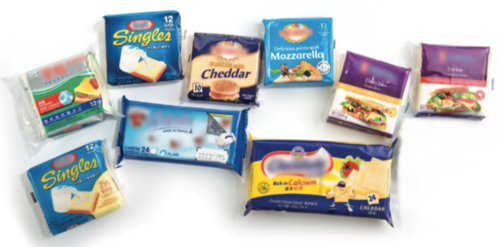
It is also known as ‘reconstituted cheese’ and the most common one is sliced cheese. Processed cheese is made by shredding and melting one or more natural cheeses, and adding various dairy ingredients such as butter, casein, milk powder, whey powder, lactic acid and lactose, etc. to achieve the desired taste, texture and meltability. Manufacturers may also add different colourings, stabilizers, anti-caking agents, preservatives, and emulsifiers to get the desired shape (e.g, slice or stick) and extend its shelf life.
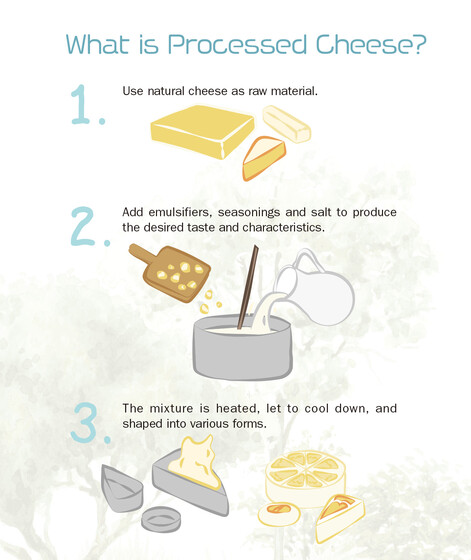
Apart from the taste, consumers may also consider the ‘cheese’ content as one of the selection criteria.
Cheese for kids – what is it?
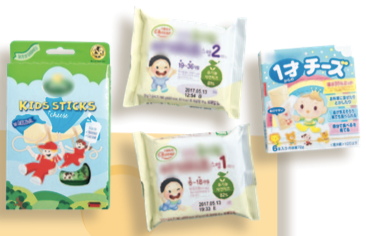
There are some cheese products on the market that are advertised as specially made for young children of various ages. These are actually a type of processed cheese. In fact, the recommended daily sodium intake limit for children aged 1 to 3 and 4 to 8 are 1,000mg and 1,400mg, respectively, but the ‘cheese for kids’ and prepackaged sliced cheese may contain a lot of salt and additives. Young children who consume too much sodium may expose to higher risks of hypertension and kidney disease in the long run.
Cheese is not a necessary dietary item for young children. If parents want their children to have a taste of cheese, they can choose a natural cheese that is made from pasteurized milk and naturally fermented to full maturity (e.g., Cheddar and Parmesan). These cheeses are generally additive-free and have lower sodium content, making them more suitable for young children aged 6 months or older. However, if any family member suffers from food allergies or lactose intolerance, or if the child suffers from asthma or eczema, it is recommended that dairy items should only be added to the diet after the child turns 1 year old to reduce the risk of food allergies and exacerbating asthma or eczema symptoms.
Cheese can be so ‘nutritious’
To many people, the first impression of cheese is "tasty but fattening". In fact, cheese is also rich in protein, calcium, phosphorus, vitamin A and vitamin B12, and can bring great benefits to the human body.
Parmesan has the highest protein content
The Council tested 40 models of cheese on the market, and 39 of them reached the "high-protein" level. On a per 100g basis, the average protein content of natural cheese samples was 22.5g. Parmesan had the highest at 30.0g while Brie had the lowest at 17.8g. The average protein content of processed cheese samples was 17.6g, with smoked cheese containing the highest (21.7g) and ‘processed cheese for kids’ containing the least (14.0g).
Certain processed cheese can be particularly high in calcium content
The calcium in cheese helps to maintain healthy bones, and control blood pressure and muscle contraction. Good lactic acid bacteria also break down lactose into lactic acid during the fermentation process. Lactic acid bacteria help digestion, inhibit the reproduction of harmful bacteria in the digestive systems, and promote the synthesis of vitamin B complex and vitamin K to maintain intestinal health. People with lactose intolerance can try to replace milk with cheese to supplement calcium intake.
The test results showed that 36 models reached the "high-calcium" level. Among them, 2 models of processed cheese had higher calcium content due to the addition of calcium phosphate.
Phosphorus is one of the elements that make up bones and teeth. The test showed that all of the 40 models reached "high-phosphorus" level.
How "evil" can cheese be?
Consumers should also beware of the potential health risk associated with poor-quality cheese and over-consumption!
Allergy-inducing preservatives
From the 40 samples tested by the Council, traces of benzoic acid, propionic acid and sorbic acid were detected. According to the Preservatives in Food Regulations in Hong Kong, benzoic acid is not allowed to be added in cheese as a preservative. Since many cheeses contain benzoic acid naturally, so the benzoic acid detected might not have been artificially added. Although no sample was found to contain excessive preservatives, people who are sensitive to these preservatives should exercise extra care.
Total bacterial count exceeding limit
Aerobic colony count is an indicator of hygienic quality and reflects the general quality and remaining shelf life of food items. In this test, 1 non-fermented cheese was found to contain 13,000,000 CFU/g, which exceeded the 10,000,000 CFU/g limit, indicating that its hygiene situation was unsatisfactory. Consumers should therefore choose products carefully.
In addition, the milk from which cheese is made may be unpasteurized raw milk, or contain pathogenic bacteria such as Listeria. Although Listeria can be killed by normal cooking temperatures, it can survive and breed in a refrigerated environment with temperature as low as 0°C. Although most healthy individuals may not experience any symptom after contracting Listeria, or only have mild symptoms such as fever, headache, vomiting, diarrhea and muscle pain, serious complications may occur in young children, the elderly and those with weak immune systems, and can be fatal. Infection of Listeria during pregnancies may lead to miscarriage, premature birth, or meningitis in newborns. Therefore, consumers should pay extra attention! In general, cheese with lower moisture content and harder texture is more difficult for bacteria to breed. On the contrary, soft cheese has a relatively high moisture content, and if unpasteurized raw milk is used as the raw material, it can be prone to bacterial growth.
High-fat and high-sodium
The most ‘evil’ trait of cheese is its high content of fat and sodium. Excessive intake of fat and sodium may increase the risk of obesity and chronic diseases such as high cholesterol, high blood pressure, and cardiovascular diseases. Consumers should therefore be extra careful when consuming cheese.
a. Fat
According to the Centre for Food Safety (CFS), food that contains more than 20g of total fat per 100g is considered a ‘high-fat’ food. From the test results, it was found that 29 out of the 40 models reached ‘high-fat’ level. On a per 100g basis, the average total fat content of natural cheese samples was 26.7g while that of processed cheese samples was 22.6g. The Chinese Nutrition Society recommends a daily fat intake limit of 60g for adults who are on a 2,000kcal-calorie diet. In other words, it is easy to exceed the limit if you don’t pay enough attention! Apart from the serving size, consumers should also select carefully as the test results revealed that the fat content could differ by as much as 24.3g (per 100g) among different cheeses!
b. Sodium
Salt is often added in the cheese-making process to:
1. | Kill the various bacteria that may affect the ripening of cheese. |
2. | Control the growth of lactic acid bacteria and mould in cheese, thereby controlling its flavor and taste. |
3. | Remove excess whey. |
4. | Neutralize the bitterness of some cheeses. |
Therefore, it is difficult for natural cheese to be low in sodium. The food additives in processed cheese, including emulsifiers and seasonings, may contain additional sodium, so the sodium content of processed cheese is generally higher than that of natural cheese. The test results showed that the average sodium content of the natural cheese per 100g sample size was 595mg while that of the processed cheese was 1,194mg (which was twice as high). 25 out of the 40 models reached ‘high- sodium’ level.
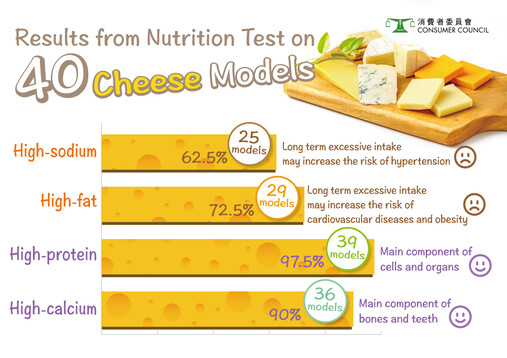
Cheese-pairing tips
We often hear that cheese and red wine is a match made in heaven. However, are all red wines good in the pairing? In addition to fruit and bread, what other foods can be paired with cheese? Let’s find out more:
Wine | Red wines that are light and fruity are more suitable to pair with cheese. For example, a dry and fresh red wine goes well with fresh goat cheese. In fact, white wines match better with a variety of cheese than red wines and some cheeses are best paired with beer. Some consumers may choose to pair cheese with wine from the same region (e.g., Belgium). |
Fruit | When paired with fruit, cheese can be quit refreshing in taste. For example, goat cheese and dried figs, blue cheese and raisins, Camembert and apples; mascarpone and strawberries, Gorgonzola and pears. |
Nuts | Dried fruit can neutralise the saltiness in cheese while dried nuts can bring out its unique flavour. So, both are suitable for pairing. |
Bread / biscuits | In general, baguette and pain de campagne are suitable to pair with different cheeses. Cheese with a strong smell is better with bread that carries strong characteristics, e.g., blue cheese that is salty and has a strong taste can be paired with sweet raisin bread. Biscuits and bread sticks are great for cheese dipping sauce and cream cheese, or as a snack in between different cheese. |
Vegetables | Carrot and cucumber sticks are great for dipping in fresh cheese such as Boursin. Mozzarella / buffalo cheese goes well with tomato on a pizza. |
Jam / honey | Jam and honey go well with fresh cheese. They make strong cheese such as blue cheese and hard cheese softer on the palate. |
Herbs / spices | A little bit of herbs or spices can add depth to the taste of cheese. |
With appropriate pairing, food can bring out the unique flavor of cheese and enhance the culinary experience. It should also be noted that except for fresh cheese, it is best to take out the cheese from the refrigerator 30 minutes prior to consumption, as cheese tastes better at room temperature.
Storage Tips
Let’s see if you store your cheese in the correct way: Once opened, most cheese should be wrapped in cling film, a storage bag or aluminum foil, then sealed in a food container or wooden box and stored in the refrigerator or in accordance with the storage instructions on the product label. The base of the food container can be lined with vegetables to prevent the cheese from drying out and cracking. It should also be noted that cheese should be stored separately from wine to prevent the latter from absorbing the smell of cheese.

If you want to find out which cheese has the highest fat and sodium content, please refer to the article ‘Cheese Are Rich in Calcium and Protein but Beware of Its High Content of Fat and Calcium’ (Chinese version only) in issue #535 of CHOICE Magazine. To get more trivia facts about cheese, you may also want to refer to the article ‘Know the Different Types of Cheese Enhance Your Culinary Experience’ (Chinese version only) in issue #483 of CHOICE Magazine.
Further reading: The secret of milk packaging
Have you ever thought that the different packaging of milk, such as gable-top carton / Tetra brik / glass bottles, etc., actually conveys certain information? What signs do you need to look for on the packaging if you want your milk to have a smoother taste? To find out more about these trivia facts, please refer to the article ‘Trivia: How to Decode Milk Packaging’ (Chinese version only).




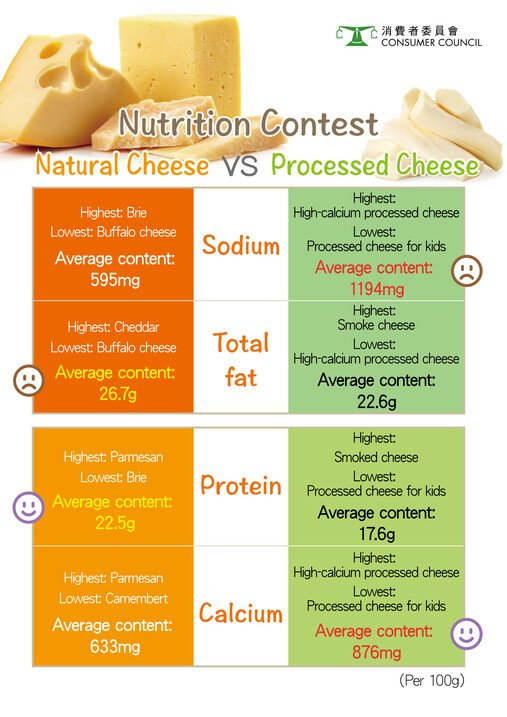
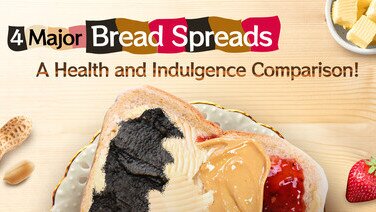
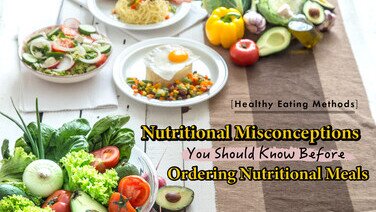

![[Baby Snacks Guide] Who Says Snacks Can’t Be Healthy?](/f/guide_detail/415742/376c212/bb%20snack.jpg)
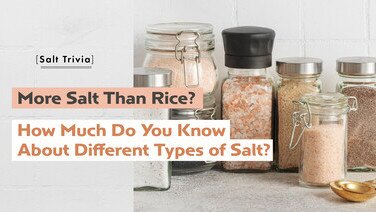


![[Handwashing Cold Knowledge] Debunking 4 common handwashing myths](/f/guide_detail/409326/376c212/43_4%E5%80%8B%E6%B4%97%E6%89%8B%E5%B8%B8%E8%A6%8B%E8%BF%B7%E6%80%9D_Eng.jpg)
